Related Research Articles

A privateer is a private person or vessel which engages in maritime warfare under a commission of war. Since robbery under arms was a common aspect of seaborne trade, until the early 19th century all merchant ships carried arms. A sovereign or delegated authority issued commissions, also referred to as letters of marque, during wartime. The commission empowered the holder to carry on all forms of hostility permissible at sea by the usages of war. This included attacking foreign vessels and taking them as prizes and taking crews prisoner for exchange. Captured ships were subject to condemnation and sale under prize law, with the proceeds divided by percentage between the privateer's sponsors, shipowners, captains and crew. A percentage share usually went to the issuer of the commission.
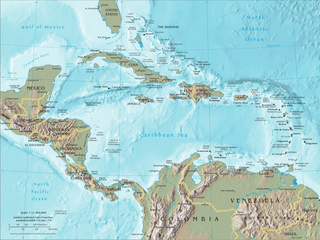
The era of piracy in the Caribbean began in the 1500s and phased out in the 1830s after the navies of the nations of Western Europe and North America with colonies in the Caribbean began hunting and prosecuting pirates. The period during which pirates were most successful was from the 1660s to the 1730s. Piracy flourished in the Caribbean because of the existence of pirate seaports such as Port Royal in Jamaica, Tortuga in Haiti, and Nassau in the Bahamas. Piracy in the Caribbean was part of a larger historical phenomenon of piracy, as it existed close to major trade and exploration routes in almost all the five oceans.
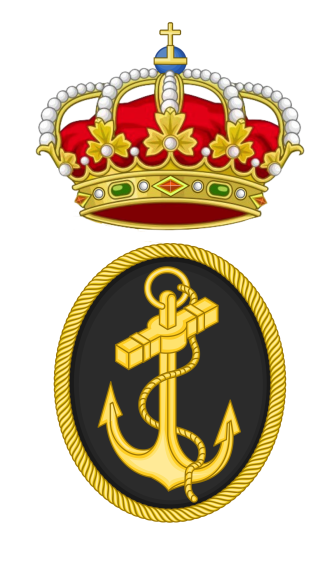
The Spanish Navy or officially, the Armada, is the maritime branch of the Spanish Armed Forces and one of the oldest active naval forces in the world. The Spanish Navy was responsible for a number of major historic achievements in navigation, the most famous being the discovery of America and the first global circumnavigation by Elcano. For several centuries, it played a crucial logistical role in the expansion and consolidation of the Spanish Empire, and defended a vast trade network across the Atlantic Ocean between the Americas and Europe, and the Manila Galleon across the Pacific Ocean between the Philippines and the Americas.

The Portuguese Empire, also known as the Portuguese Overseas or the Portuguese Colonial Empire, was composed of the overseas colonies, factories, and later overseas territories, governed by the Kingdom of Portugal. It was one of the longest-lived colonial empires in European history, lasting 584 years from the conquest of Ceuta in North Africa in 1415, to the transfer of sovereignty over Macau to China in 1999. The empire began in the 15th century, and from the early 16th century it stretched across the globe, with bases in Africa, North America, South America, and various regions of Asia and Oceania.
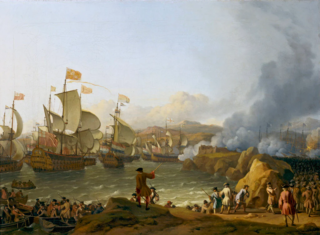
The Battle of Vigo Bay, also known as the Battle of Rande, was a naval engagement fought on 23 October 1702 during the opening years of the War of the Spanish Succession. The engagement followed an Anglo-Dutch attempt to capture the Spanish port of Cádiz in September in an effort to secure a naval base in the Iberian Peninsula. From this station the Allies had hoped to conduct operations in the western Mediterranean Sea, particularly against the French at Toulon. The amphibious assault, however, had proved a disaster, but as Admiral George Rooke retreated home in early October, he received news that the Spanish treasure fleet from America, laden with silver and merchandise, had entered Vigo Bay in northern Spain. Philips van Almonde convinced Rooke to attack the treasure ships, despite the lateness of the year and the fact that the vessels were protected by French ships-of-the-line.
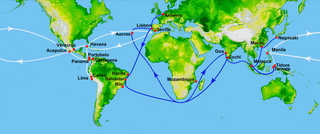
The Spanish treasure fleet, or West Indies Fleet, was a convoy system of sea routes organized by the Spanish Empire from 1566 to 1790, which linked Spain with its territories in the Americas across the Atlantic. The convoys were general purpose cargo fleets used for transporting a wide variety of items, including agricultural goods, lumber, various metal resources such as silver and gold, gems, pearls, spices, sugar, tobacco, silk, and other exotic goods from the overseas territories of the Spanish Empire to the Spanish mainland. Spanish goods such as oil, wine, textiles, books and tools were transported in the opposite direction.

The Portuguese Navy is the naval branch of the Portuguese Armed Forces which, in cooperation and integrated with the other branches of the Portuguese military, is charged with the military defense of Portugal.
This timeline of the history of piracy in the 1680s is a chronological list of key events involving pirates between 1680 and 1689.
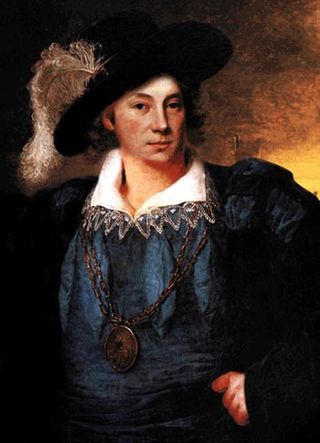
Laurens Cornelis Boudewijn de Graaf was a Dutch pirate, mercenary, and naval officer in the service of the French colony of Saint-Domingue during the late 17th and early 18th century.

Castillo San Salvador de la Punta is a fortress at the entrance to the bay in Havana, Cuba.

Spain–United Kingdom relations, also called Spanish–British relations or Anglo-Spanish relations, are the bilateral international relations between Spain and United Kingdom. Both countries are members of the Council of Europe and NATO. Spain is a European Union member and the United Kingdom is a former European Union member.

Havana was founded in the sixteenth century displacing Santiago de Cuba as the island's most important city when it became a major port for Atlantic shipping, particularly the Spanish treasure fleet.
The maritime history of England involves events including shipping, ports, navigation, and seamen, as well as marine sciences, exploration, trade, and maritime themes in the arts of England. Until the advent of air transport and the creation of the Channel Tunnel, marine transport was the only way of reaching the rest of Europe from England and for this reason, maritime trade and naval power have always had great importance. Prior to the Acts of Union in 1707, the maritime history of the British Isles was largely dominated by England.
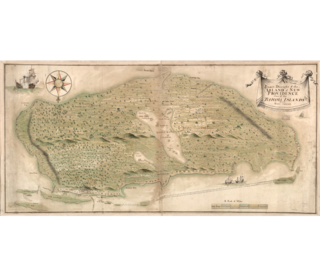
The Raid on Nassau was a Spanish military expedition that took place in February 1720 during the War of the Quadruple Alliance wherein Spanish forces assaulted the British settlement of Nassau in an attempt to seize the island of New Providence. Although the Spanish managed to raid outlying posts, the assault on Nassau itself was repelled and the invasion was a failure.

A patache is a type of sailing vessel with two masts, very light and shallow, a sort of cross between a brig and a schooner, which originally was a warship, being intended for surveillance and inspection of the coasts and ports. It was used as a tender to the fleet of vessels of more importance or size, and also for trans-Pacific travel, but later began to be used for trading voyages, carrying cargo burdens of 30 tons or more.

The Battle of Sabana Real took place on January 21, 1691. An army of 700 Dominican raiders and 2,600 militiamen aboard five warships of the Armada de Barlovento, circled and overwhelmed 1,000 French defenders at Sabana de la Limonade; Governor de Cussy and 400 of his followers were killed.
Luis Fajardo y Ruíz de Avendaño,, known simply as Luis Fajardo, was a Spanish admiral and nobleman who had an outstanding naval career in the Spanish Navy. He is considered one of the most reputable Spanish militaries of the last years of the reign of Philip II and the reign of Philip III. He held important positions in the navy and carried out several military operations in which he had to fight against English, Dutch, French and Barbary forces in the Atlantic, the Caribbean and the Mediterranean. He is known for the conquest of La Mamora in 1614.

A zabra (zah-brə) was a small or midsized sailing vessel used off the coasts of Spain and Portugal to carry goods by sea from the 13th century until the mid-16th century; they were well-armed to defend themselves against pirates and corsairs.

The Royal Arsenal of Havana was located South East of the Campo de Marte and played a prominent role in Spanish shipbuilding in the 18th century. In total, seventy-four warships were built in Havana during this century.
Pedro Velaz de Medrano y Manso de Zúñiga, II Lord of Tabuérniga was the captain general of the Armada de Barlovento and custodian of the Fleet of New Spain, governor of the Tercio of Álava, governor of five galleons from Naples, sailor and prominent Spanish noble during the reign of Felipe IV. He is famous for having captained a French corsair flotilla in the Caribbean with the intention of capturing the Spanish treasure fleet for King Louis XIV of France. He married María de Altamirano y Ponce de León. His son Don Antonio Velaz de Medrano y Altamirano, Governor of the strategic city of Nieuwpoort became the I Marquis of Tabuerniga, granted by King Carlos II of Spain in 1682.
References
- Pirates of the Americas, Volume 1 by David F. Marley (ABC-CLIO, 2010)
- The Buccaneer's Realm: Pirate Life on the Spanish Main, 1674-1688 by Benerson Little (Potomac Books, 2007)